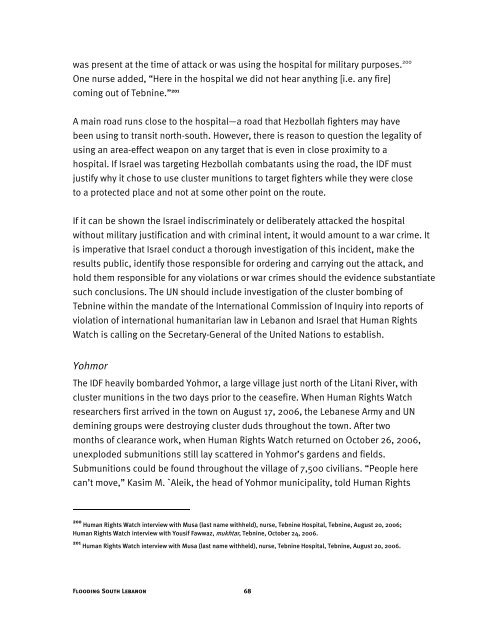Flooding South Lebanon - Human Rights Watch
Flooding South Lebanon - Human Rights Watch
Flooding South Lebanon - Human Rights Watch
Create successful ePaper yourself
Turn your PDF publications into a flip-book with our unique Google optimized e-Paper software.
was present at the time of attack or was using the hospital for military purposes. 200<br />
One nurse added, “Here in the hospital we did not hear anything [i.e. any fire]<br />
coming out of Tebnine.” 201<br />
A main road runs close to the hospital—a road that Hezbollah fighters may have<br />
been using to transit north-south. However, there is reason to question the legality of<br />
using an area-effect weapon on any target that is even in close proximity to a<br />
hospital. If Israel was targeting Hezbollah combatants using the road, the IDF must<br />
justify why it chose to use cluster munitions to target fighters while they were close<br />
to a protected place and not at some other point on the route.<br />
If it can be shown the Israel indiscriminately or deliberately attacked the hospital<br />
without military justification and with criminal intent, it would amount to a war crime. It<br />
is imperative that Israel conduct a thorough investigation of this incident, make the<br />
results public, identify those responsible for ordering and carrying out the attack, and<br />
hold them responsible for any violations or war crimes should the evidence substantiate<br />
such conclusions. The UN should include investigation of the cluster bombing of<br />
Tebnine within the mandate of the International Commission of Inquiry into reports of<br />
violation of international humanitarian law in <strong>Lebanon</strong> and Israel that <strong>Human</strong> <strong>Rights</strong><br />
<strong>Watch</strong> is calling on the Secretary-General of the United Nations to establish.<br />
Yohmor<br />
The IDF heavily bombarded Yohmor, a large village just north of the Litani River, with<br />
cluster munitions in the two days prior to the ceasefire. When <strong>Human</strong> <strong>Rights</strong> <strong>Watch</strong><br />
researchers first arrived in the town on August 17, 2006, the Lebanese Army and UN<br />
demining groups were destroying cluster duds throughout the town. After two<br />
months of clearance work, when <strong>Human</strong> <strong>Rights</strong> <strong>Watch</strong> returned on October 26, 2006,<br />
unexploded submunitions still lay scattered in Yohmor’s gardens and fields.<br />
Submunitions could be found throughout the village of 7,500 civilians. “People here<br />
can’t move,” Kasim M. `Aleik, the head of Yohmor municipality, told <strong>Human</strong> <strong>Rights</strong><br />
200 <strong>Human</strong> <strong>Rights</strong> <strong>Watch</strong> interview with Musa (last name withheld), nurse, Tebnine Hospital, Tebnine, August 20, 2006;<br />
<strong>Human</strong> <strong>Rights</strong> <strong>Watch</strong> interview with Yousif Fawwaz, mukhtar, Tebnine, October 24, 2006.<br />
201 <strong>Human</strong> <strong>Rights</strong> <strong>Watch</strong> interview with Musa (last name withheld), nurse, Tebnine Hospital, Tebnine, August 20, 2006.<br />
<strong>Flooding</strong> <strong>South</strong> <strong>Lebanon</strong> 68
















